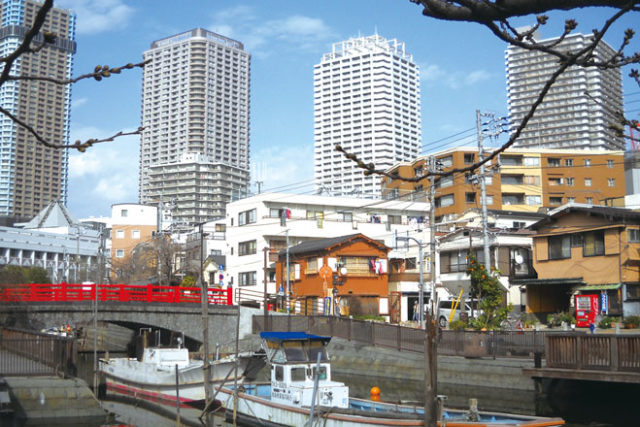By Yukiko Tanaka
For The North American Post
As you can see in woodcut prints by, for instance, Katsushika Hokusai, Tsukudajima was possibly a tiny island or a landmass with sandy beach, naturally formed rather than reclaimed land. Some Osaka-area fishermen settled on this island by the order of Tokugawa Ieyasu. It was in very early Edo years in early 17th century that they were to fish for the consumption of the shogun’s large household. The leftovers were then sold at the market located by the bank of Nihonbashi River. In a small park on the island is a reproduction of a fire lookout that belong to that era.
You can go to Tsukudajima island directly from Akashicho area by crossing a bridge. The walk to cover much of it takes half an hour or so. Surrounded by water on its three sides, its northern tip in particular is occupied by several tall condominiums, or “tower manshons,” with a narrow strip of public walkways around. With a superb view and close relative proximity to Ginza, real estate value here is quite high. Some say it is not so convenient to live here without a shopping center or mall, but that can be attractive and rare in the overly commercial city of Tokyo. With a primary school, a few parks, a shrine, canals, there are active lives and a small community here.
Tsukuda-ni are tiny fish cooked in soy sauce and sugar and it is a favorite food the Japanese have been enjoying for a long time, perhaps since the beginning of Edo. Tsukuda-jima, it is said, is where it was originated. Some years ago, while walking this neighborhood, I spotted a tiny store selling tsukuda-ni and I bought some, believing it was local. When I looked at the packet carefully at home, however, I saw “product of China” written on it. The days of Ieyasu catching fish off shore are no longer possible, I had to remind myself.
This time I found a couple of large stores where they make and sell tsukuda-ni, but I was amazed at how expensive they are. More than those fish, however, I enjoyed looking at the large houses that accommodate the store; their structure presented the beauty of old and well-preserved unpainted wood.
Behind those stores is a small shrine, Sumiyoshi Shrine, and it is here you will find the superb work of curving and engraving done on the unpainted wood surface of the shrine’s structure. Surely that of a very skillful artisan(s), they depict the life and work of sailors and those who fish. Sumiyoshi Shrine is where a god protecting those who work at sea is worshipped, and presumably it was those who were brought here to do the fishing who started this shrine.
Some residents of Tsukudajima engage in boating and fishing today, although their number has dwindled in recent years. You see their boats moored on the canal that goes through the island. There is a bridge, painted in that characteristic red that you see in Shinto shrines, which is wooden and slightly arched in the middle, like the old style formerly characteristic of Nihonbashi. When you learn that this enclave has escaped not only from the bombings of the war but was also relatively unaffected by the Great Kanto Earthquake, you can see why a few precious and valuable landmarks exist today on this island.
[Editor’s Note]
This series will be published every week. The writer can be reached atytanaka03@gmail.com.






